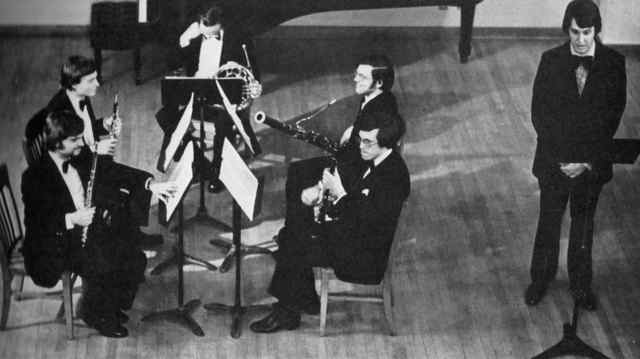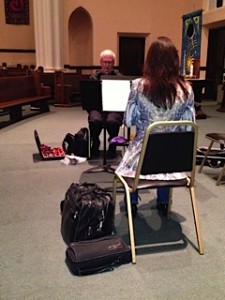Today, Wednesday, May 25, 2022, marked the first school program since March 2020! A very long 2+ years… the C Street Brass joined four of the Renaissance City Winds for a performance and career workshop for the Norwin High School band program. The group revived Igor Stravinsky’s Octet from their series concerts in Fall 2019. Always gratifying to revisit and perform a difficult yet classic work like this, and to share it with a very interested group of student musicians. Afterwards, they had excellent questions about preparing music, performing chamber music, and guidance with possible music careers. A heartfelt thanks to the H. O. Peet Foundation for underwriting this performance!
Author Archives: Jim Whipple
Granted!
 The Winds were just awarded a $13,000 grant from the Small Arts Initiative of the Heinz Endowments. This will support two performances of a collaborative project with the Beo String Quartet in the late spring of 2022; exact dates and venues are currently being worked out.
The Winds were just awarded a $13,000 grant from the Small Arts Initiative of the Heinz Endowments. This will support two performances of a collaborative project with the Beo String Quartet in the late spring of 2022; exact dates and venues are currently being worked out.
The program will feature two wonderful but neglected works. The first is the Oktett by Egon Wellesz, commissioned by the Vienna Octet for string quintet (including double bass), clarinet, horn, and bassoon. Wellesz, of Jewish descent, was well into a highly successful career in Austria when the advent of Nazism forced him to flee to England. Described as a “perennial outsider,” the Austrians didn’t want him back after the war and the English regarded him as a mere academic (by 31 he had deciphered the notation of Byzantine music). His stunning Oktett of 1949 captures the emotional journey of Europeans in the middle of the twentieth century.
The second work is the Nonet in E-flat Major, Op. 38, by French composer Louise Farrenc. A fine pianist who received first-rate instruction in Paris, she married the flutist Aristide Farrenc in 1821. Wearying of constant touring after a few years, they started a publishing house which became one of the leading French publishers. Initially writing for her own instrument, she expanded into chamber music beginning in the 1830s. Her nonet, from 1849, was so successful that it allowed her to bargain for pay equity with the male teachers at the famed Paris Conservatory, where she was the only female professor in the entire nineteenth century. And yet the work still did not get published until the twenty-first century! Beo and the Winds will surely be giving the Pittsburgh premiere of her nonet.
The Heinz Endowments is devoted to the mission of helping our region prosper as a vibrant center of creativity, learning, and social, economic and environmental sustainability. Core to our work is the vision of a just community where all are included and where everyone who calls southwestern Pennsylvania home has a real and meaningful opportunity to thrive.
Photos, left to right:
Egon Wellesz (1885-1974), Louise Farrenc (1804-1875)
What’s in a capital letter?
“classical music” (with a small “c”) is music that is written down, rather than improvised (made up on the spot by the performer) or passed on by memorizing what someone hears from another person singing or playing. Because it’s written down, the piece can be performed far away and long after its creation, by someone who’s never heard it before. The notation doesn’t particularly affect the expressive content of the music; such music can be in many, many different styles and moods. After all, a “classical” concert could include an 11th century chant by Hildegard, an eight-part mass by Lassus, an ingenious fugue by Bach, a syncopated rag by Scott Joplin, or a dynamic work written a few weeks ago by some Pittsburgh composer.
Unfortunately, a lot of confusion has been caused by using “Classical” (with a capital “C”) as a specific label for music composed between roughly 1750 and 1825, primarily in Europe. One result of that confusion is that many people don’t realize that classical music (with a small “c”) is still being composed today! However, this week’s Winds concert features truly Classical music: a quintet by the German composer Franz Danzi from 1823 and a quartet by the French composer André-Frédéric Eler from 1805. And the Christmas carols can be described as “classic” with yet a slightly different meaning of the word: “a work of art of recognized and established value.”
Young Composers
A common thing to see when walking into a high school band or choral rehearsal room is posters of great composers hanging on the walls. Inevitably, they show elderly men, often with beards and clothing clearly belonging to centuries past. So it’s easy to forget that much of their noteworthy work was written when they were young, long before they became famous.
The Winds’ upcoming concert at the Panza Gallery features a number of pieces written by young composers. Opening the program is Viaggio by Stephanie Simon. Ms. Simon completed her masters‘ degree in composition at Carnegie Mellon University in 2018; we recorded her piece for the school in 2017, and liked it so much we premiered it on our concert series later that spring. Even younger are the composers of two miniatures by Emily Larrimer and Katy Pietruskinski, who were respectively in sixth and eighth grade when they were students of mine in the MEET THE COMPOSER residency in the 2000s. Both pieces will be performed in wind quintet settings that I made for the Winds.
And Mladen Pozajic, subject of the previous post about this concert, was just a twenty-year-old student at the Zagreb Academy of Music when he penned his Tri Stavka.
R. James Whipple
Millvale’s Croatian Connection
The Winds’ upcoming concert at the Panza Gallery features a distinctive and colorful work by the Croatian composer, Mladen Pozajic. We discovered this work in the 1990s when we were doing a Music for Neighborhoods concert in Millvale’s St. Nicholas Croatian Catholic Church. The church’s interior is covered by 25 murals (approximately 4500 square feet!) by the immigrant artist Maxo Vanka (1889-1963), which depict Croatian life in the old country and the New World. In those murals, Vanka both pays tribute to his faith and expresses his passionate beliefs about social justice, injustice, and the horrors of war.
A violinist who was a refugee from the horrors of the 1990s Bosnian war assisted us in researching Croatian music for our concert in the church. One of the most striking of those pieces was the Tri Stavka [Three Movements], written by the twenty-year-old Mladen Pozajic in 1925. Unpublished at the time, we had to create our own parts from a manuscript score. Since then, it has been published by Editions Viento. Written for double-reed quartet (two oboes, English horn, and bassoon), the Winds will be presenting this music adapted for wind quartet of oboe, clarinet, French horn, and bassoon.
R. James Whipple
Paul Valjean – one of those “one-work” wonders!
Pittsburgh’s NPR classical music station, WQED-FM 89.3, sometimes plays pieces by what they call “one-work wonders,” composers who are known only by a single work. Usually such composers wrote more, but only one – justifiably or not – has captured the music community’s collective ear and made it into the repertoire. On rare occasions, such composers truly only wrote one piece – which made it! Such a work is the 1955 Dance Suite of Paul Valjean, written when the composer was a 20-year-old student at the Eastman School of Music, studying bassoon with K. David Van Hoesen (father of Pittsburgh Symphony harpist Gretchen Van Hoesen). The suite was written for a show organized by Eastman School of Music bassoon students, “The Bassoonists’ Ballet.”
Paul Valjean went on to a career as a dancer and choreographer, and apparently composed no more. His Dance Suite, however, developed a life of its own and became popular with wind groups, being distributed through multiple generations of photocopies before its ultimate publication in 2000. You can hear it yourself on the Winds’ Holiday Express concert, Saturday November 26th at 8pm!
Forty years ago…
Forty years ago this month, Eric Draper approached David Tessmer and Jim Whipple – all of whom were playing in the Carnegie Civic Symphony (now the Pittsburgh Civic Orchestra) about starting a wind quintet. Adding Eric’s friend and classmate from Duquesne University Mike Jacob on clarinet and hornist Mark Thompson from Carnegie Mellon, the Renaissance City Woodwind Quintet was off and running, and gave their first performance in an elementary school in Chartiers-Houston School District that fall. Later that season, the group won the Pittsburgh Concert Society Auditions. Shown here is the group with baritone Rob Ferrier performing one of their winning selections, the Pügesange by American composer Brian Holmes, on the Concert Society Series the following season. By this time Jeffrey Ellrod had taken the place of Mark Thompson on horn, who had moved away to attend graduate school. Just look at all that dark hair!
Clockwise, from the lower-left corner:
. . . David Tessmer, flute
. . . Eric Draper, oboe
. . . Jeffrey Ellrod, horn
. . . R. James Whipple, bassoon
. . . Michael Jacob, clarinet
with Robert Ferrier, baritone
What’s an “aguinaldo?”
An aguinaldo is a genre of Venezuelan Christmas carol. Our concert of Latin American music features three of these. Luna Decembrina (“December Moon”) is an instrumental version of a choral setting by Gilberto Rebolledo, and is especially catchy with its hemiola rhythms (3/4 figures in a 6/8 meter). Our long-time collaborating composer Efraín Amaya arranged two more for this program, Niño Lindo (“Pretty Child”) and Cantemos, Cantemos! (Sing, Sing!). In Venezuela, the musicians are typically rewarded with food and drink, but at our concert the audience gets treated to the reception as well, not to mention the tour of the toy train museum afterwards!
Venezuelan/American composer Efraín Amaya. The program also includes his Kaleidoscope, written for the Winds through the Pittsburgh New Residency.
The Power of Two
The latest addition to the Winds’ repertoire this month is Contrapunctus VI from The Art of Fugue by J.S. Bach, in a brand new transcription for wind quintet by composer/bassoonist R. James Whipple. In this amazing piece, Bach casts the theme (the “subject”) against itself moving twice as fast, and often upside-down (“inverted”)! It’s pretty wild to hear one part enter after another but finish first! And this isn’t all; there’s a direction that the piece is to be performed in “French overture” style, so all the dotted rhythms become “doubly-dotted” which means that the short notes are twice as fast! You can hear this amazing creation on the Winds’ concerts on Saturday and Sunday, May 17-18. Here’s what the first page looks like (the dashed brackets show where the theme is inverted).
RCW reed trio opens Johnstown series
The Winds’ reed trio of oboe, clarinet, and bassoon opened the newly-renamed Johnstown Concert Series (formerly the “Chamber Music Series of Greater Johnstown”) on Saturday, September 28th. The downtown Third Presbyterian Church was an absolute stunning space with at least a three-second reverb! The program included French and American works from the 19th and 20th centuries, transcriptions of two Bach fugues from the Well-Tempered Clavier and a suite of Renaissance pieces, and an unaccompanied bassoon solo based on Innuit folk music by the late Canadian composer Milton Barnes, performed by bassoonist R. James Whipple.












